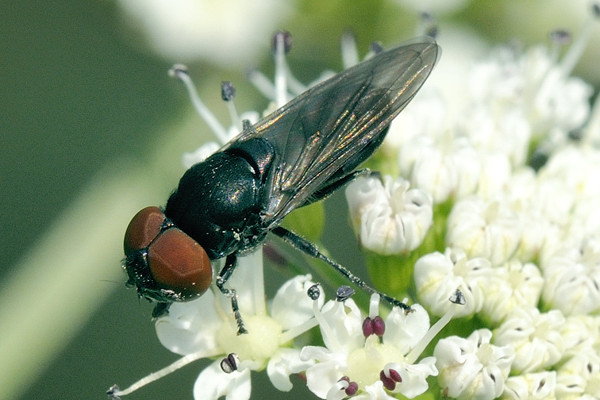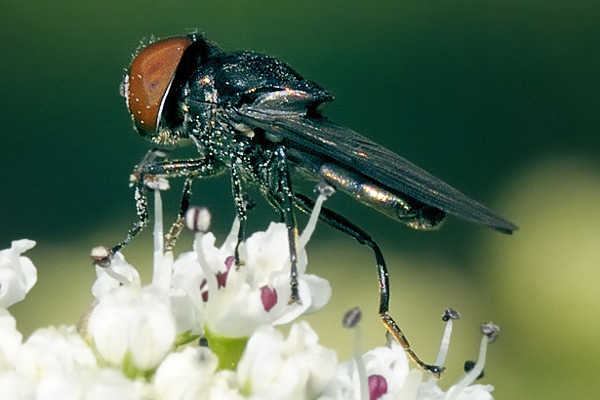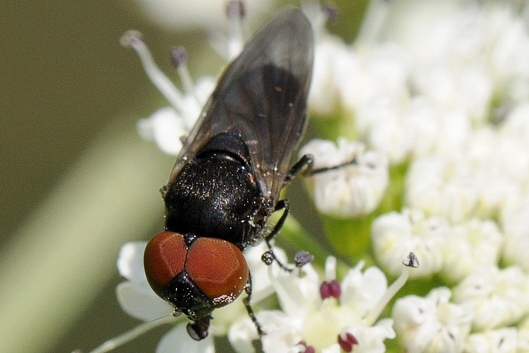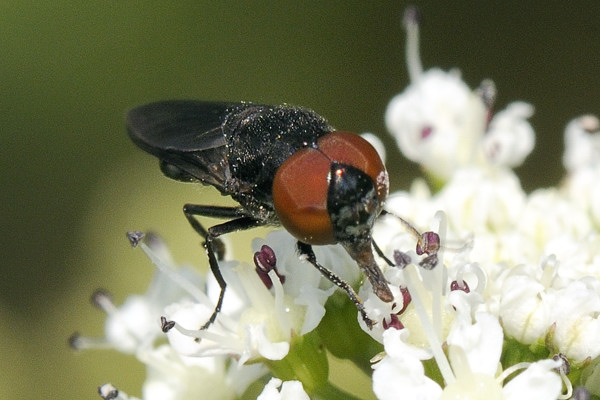Diptera.info :: Family forums :: Syrphidae
|
Chyrsogaster solstitialis - thanks Andre
|
|
| nick upton |
Posted on 20-03-2010 20:07
|
|
Member Location: Wiltshire, UK Posts: 828 Joined: 12.03.10 |
Can anyone tell me if this is a Platypezid, Flat-footed fly and if it is possible to identify it at least to genus? Only small, maybe 5mm, so hard to get good shots. Feeding on Angelica flowers, 30.5.09 in Wiltshire Nick Upton nick upton attached the following image:  [133.72Kb] Edited by nick upton on 06-05-2010 10:06 |
|
|
|
| nick upton |
Posted on 20-03-2010 20:08
|
|
Member Location: Wiltshire, UK Posts: 828 Joined: 12.03.10 |
And a lateral view of the same fly NickU nick upton attached the following image:  [118.13Kb] |
|
|
|
| Paul Beuk |
Posted on 20-03-2010 20:25
|
|
Super Administrator Location: Netherlands Posts: 19403 Joined: 11.05.04 |
Syrphidae.
Paul - - - - Paul Beuk on https://diptera.info |
| nick upton |
Posted on 20-03-2010 20:37
|
|
Member Location: Wiltshire, UK Posts: 828 Joined: 12.03.10 |
OK many thanks. Any idea on genus? I'll put it up on the Syrphidae section instead if no-one can helps get it closer in this section of the site. Nick |
|
|
|
| tim worfolk |
Posted on 20-03-2010 21:59
|
|
Member Location: Devon, England Posts: 737 Joined: 05.05.09 |
Chrysogaster solstitalis Tim |
|
|
|
| Paul Beuk |
Posted on 20-03-2010 23:53
|
|
Super Administrator Location: Netherlands Posts: 19403 Joined: 11.05.04 |
,,, solstitialis? 
Paul - - - - Paul Beuk on https://diptera.info |
| tim worfolk |
Posted on 21-03-2010 08:33
|
|
Member Location: Devon, England Posts: 737 Joined: 05.05.09 |
Quite right Paul, very sloppy of me...I'm glad someone's checking my posts - I might be getting away with all kinds of rubbish. Tim |
|
|
|
| nick upton |
Posted on 21-03-2010 18:43
|
|
Member Location: Wiltshire, UK Posts: 828 Joined: 12.03.10 |
Many thanks Tim and Paul. Now I've found some pics of Chrysogaster solstitialis (with 3 is!) it's an easy match. i didn't realise Syphidae could come in such small packages... but now I've read more, everything is right, including the habitat - feeding on Angelica right beside a stream. I'll know it immediately next time. Nick |
|
|
|
| tim worfolk |
Posted on 21-03-2010 19:11
|
|
Member Location: Devon, England Posts: 737 Joined: 05.05.09 |
Nick, you'll be pleased to hear that we have three species of Chrysogaster in Britain - shouldn't be too difficult to separate with good photos though, in this case it's the face, antennae and sides of the thorax you need to look for. Tim |
|
|
|
| nick upton |
Posted on 22-03-2010 18:10
|
|
Member Location: Wiltshire, UK Posts: 828 Joined: 12.03.10 |
OK, thanks again. I'll know the genus at least next time, and with only 3 members, how hard can it be.... Nick |
|
|
|
| Andre |
Posted on 22-03-2010 19:52
|
|
Member Location: Tilburg, the Netherlands Posts: 2111 Joined: 18.07.04 |
Melanogaster nuda male. Used to be in the genus Chrysogaster, but the species with black antennae now belong to a separate genus. |
| nick upton |
Posted on 22-03-2010 21:38
|
|
Member Location: Wiltshire, UK Posts: 828 Joined: 12.03.10 |
Thanks Andre, but I am a bit confused now. I can't find any UK records of Melanogaster nuda, or of Chrysogaster nuda - its old old name - and have even checked the Uk hoverfly recoding scheme website: www.hoverfly.org.uk So either I've missed some records, or this is a new UK record, or this is Chrysogaster solsitialis with a trick of the light making the antennae looking to dark.... Any thoughts?? Nick |
|
|
|
| tim worfolk |
Posted on 22-03-2010 22:49
|
|
Member Location: Devon, England Posts: 737 Joined: 05.05.09 |
Not surprised to hear I got it wrong Andre but, as Nick says, Melanogaster nuda is not on the UK list - I'm even more confused. Tim |
|
|
|
| nick upton |
Posted on 24-03-2010 18:56
|
|
Member Location: Wiltshire, UK Posts: 828 Joined: 12.03.10 |
I hope that Andre or another Syrphid expert chimes in again on this one.... If Andre is sure this is Melanogaster nuda, this might be a new UK record. My cautious instinct says it might actually be your (confused of Topsham) original ID: Chrysogaster solstitialis, with the apparent darkness of the antennae being due to them being in shadow in my shot. I only got these two views, so can't shed any more light on them... Maybe I should start a new thread saying New UK Syrphid record??? to get some attention, or maybe i'll just go to the same pace in May to look for more of these tiny black syrphids, and get some well lit antenna close ups if I can! Nick |
|
|
|
| tim worfolk |
Posted on 24-03-2010 19:12
|
|
Member Location: Devon, England Posts: 737 Joined: 05.05.09 |
No, Andre's the expert and I'm sure he's correct with Melanogaster - thoracic dorsum appears to have short hairs and antennae do appear to be all dark so cannot be Chrysogaster. But which one? According to Stubbs & Falk, it's down to the colour of the hairs on the dorsum - not possible to see on these shots. I've no idea about nuda though. Tim |
|
|
|
| nick upton |
Posted on 24-03-2010 19:54
|
|
Member Location: Wiltshire, UK Posts: 828 Joined: 12.03.10 |
OK sounds like you go along with Andre and I'll bow to your combined expertise for sure! I've now looked at the original much higher res photos and if the critical characters for Melanogaster nuda are that the antennae are black - rather than brownish (as in most photos i've check of C. solstitiana) and that the thorax has short hairs on the dorsal surface (as opposed to a smoother thorax in C Solstitiana) then these characters do seem to be present. The hairs look black to me, exactly the same colour as the thorax. The wings seem very transparent too, and C. solsititana wings seem darker black or brown tinted in most photos. Maybe I should try to contact someone at the UK hoverfly recording scheme, to see if they know of any records for Melanogaster nuda and could send them my pics for their verdict. Nick |
|
|
|
| nick upton |
Posted on 24-03-2010 23:54
|
|
Member Location: Wiltshire, UK Posts: 828 Joined: 12.03.10 |
I found 2 more photos of this Melanogaster sp. stored on discs, and with the light at a different angle, the hairs on the thorax look more silvery/white than black (and the wings look darker..). Dunno what that suggests it is, not having access to a key. I have found photos of Melanogaster hirtella, the commoner of the 2 British species I've found records of. http://www.commanster.eu/commanster/Insects/Flies/Syrphidae4.html http://syrphidae.3644.co.uk/srph/ms.html Its hairs look more golden on these opics, but more silvery on this one http://www.diptera.info/photogallery.php?photo_id=4743 The other, rarer "British" species seems to be Melanogaster aerosa but I can't find any photos of it. So is my fly one of the 2 "British" species or is it really M. nuda , possibly a new UK record... Posting images on the hoverfly recording scheme looks tricky, so haven't cracked how to get help from there yet. Nick nick upton attached the following image:  [175.94Kb] Edited by nick upton on 24-03-2010 23:57 |
|
|
|
| nick upton |
Posted on 25-03-2010 00:03
|
|
Member Location: Wiltshire, UK Posts: 828 Joined: 12.03.10 |
final photo:
nick upton attached the following image:  [124.68Kb] |
|
|
|
| Andre |
Posted on 26-03-2010 19:34
|
|
Member Location: Tilburg, the Netherlands Posts: 2111 Joined: 18.07.04 |
With these two new pics I have to change my opinion. Sorry for the confusement, the colors in the pics are very strange... Plus I cannot see reddish third antennae, but it seems that they are very dark in this specimen. So Tim was correct in the first place: it is Chrysogaster solstitialis. (And indeed, I didn't know, nuda (= viduata) is not present in the UK  ) ) |
| nick upton |
Posted on 26-03-2010 20:22
|
|
Member Location: Wiltshire, UK Posts: 828 Joined: 12.03.10 |
OK, many thanks for your further input on this, Andre, and no need to apologise; I'm amazed and gratified by the amount of helpful expert advice I've had from this forum on photos that have often been much cropped and are often focused in the wrong place for the critical characters! I'm slowly learning what to focus on for different families and genera to aid identification and in future may compose some photos to look good, others to ensure identification is possible! As for the light in these photos, I always use natural daylight rather than flash, which to me looks more natural, but it does mean the photos are not always front lit and shadows can fall on key areas as they may have in the first pictures I posted. Nick |
|
|
|
| Jump to Forum: |













